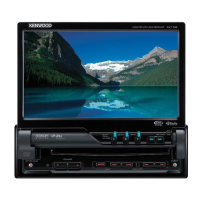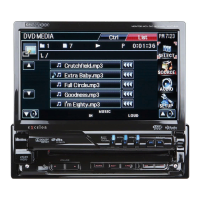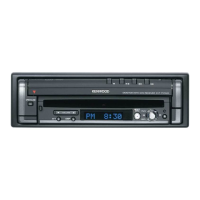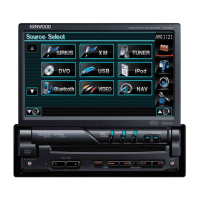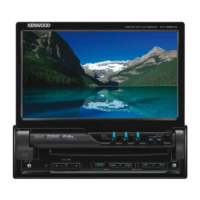Do you have a question about the Kenwood KVT-M700 and is the answer not in the manual?
Essential warnings to prevent injury, fire, and damage during operation and installation.
Explanation of the Radio Data System (RDS) features and benefits.
Details on the Mask Key system for unit authorization and theft prevention.
Notes regarding connection compatibility for disc changers and CD players.
Guidelines for cleaning the unit's faceplate and components.
Instructions for operating the monitor's mechanical functions and power states.
How to switch the monitor's picture source and screen display modes.
Selecting AV output modes and accessing angle/screen control features.
Detailed guide to adjusting monitor angle, slide position, and picture quality.
Overview of the on-screen control and source control screen interfaces.
How to access and navigate the primary menu screen.
Steps to select setup, sound, tuner, and other specific menu categories.
How to access and navigate the main setup menu screen.
Instructions for synchronizing and manually adjusting the unit's clock.
Setting up and using the security code and Mask Key functions.
Calibrating the touch panel for accurate input response.
Settings for AV input modes, RGB, and AV output.
Introduction to the system setup screens and their layout.
Configuring touch sensor tones and on-screen display behavior.
Managing disabled system indicators and button illumination colors.
Adjusting navigation voice output and sound attenuation during calls.
Accessing and navigating the main tuner setting menu.
Configuring news bulletins, alternative frequencies, and region restrict.
Setting region restrictions for RDS and enabling auto TP seek.
Selecting the appropriate TV broadcast area for optimal viewing.
Navigating the sound menu and adjusting balance, fader, and loudness.
Configuring Bass Management System and volume offset settings.
Utilizing System Q presets and configuring System Es parameters.
Setting speaker types and adjusting tone controls for optimal sound.
Overview of the on-screen control and source selection screens.
Switching between different audio sources like tuner, CD, and AV.
Adjusting playback volume and using the attenuator function.
Configuring loudness compensation and non-fading audio output.
Changing background modes and customizing function buttons.
Managing audio muting during incoming telephone calls.
Overview of the FM/AM tuner interface and control screens.
Switching between FM/AM bands and performing station tuning.
Storing and recalling favorite stations, and automatic memory entry.
Configuring seek modes and optimizing reception quality.
Managing traffic information broadcasts and setting volume.
Viewing radio text information and navigating through it.
Browsing station lists and searching by program type (PTY).
Using the FM/AM list screen to select bands and stations.
Searching for stations based on program type and language.
Overview of AV control screen interfaces and modes.
Selecting TV preset bands and AV input sources.
Configuring seek modes and selecting TV channels.
Storing and recalling preset AV stations.
Browsing and selecting stations from the TV list screen.
Automatically storing stations and recalling preset AV channels.
Accessing the name set screen for AV source customization.
Overview of the CD player interface and control screens.
Instructions for pausing, playing, fast forwarding, and reversing CDs.
Using track search, repeat, scan, and random play features.
Accessing the name set screen for CD title customization.
Overview of the disc changer interface and control screens.
Basic playback, FF/Reverse, and track search operations.
Using album search, repeat, track scan, and random play features.
Browsing disc lists, switching displays, and viewing text information.
Selecting discs and accessing the name set screen for customization.
Overview of the screen used for naming stations and discs.
Step-by-step guide to entering names for stations and discs.
Overview of DAB tuner settings, screens, and announcement modes.
Managing DAB services, bands, seek modes, and preset memory.
Configuring traffic announcements, ensemble information, and PTY search.
Selecting and searching for languages within the DAB tuner.
Overview of the screen for external display management.
Methods for switching the display output on external devices.
Overview of the screen for managing sensor box functions.
Steps to access and configure sensor box settings and items.
Using the remote for monitor and source selection functions.
Controlling FM/AM tuner functions via remote.
Instructions for loading and replacing remote control batteries.
Remote control functions for AV, DAB tuner, and disc operations.
List of included accessories and initial installation steps.
Detailed steps for installing the monitor and receiver units.
Instructions for removing the monitor unit and general connection diagrams.
Specifics on ISO connector wiring, AV equipment connections, and power control.
Common problems related to power, monitor, sound, and basic functions.
Solutions for issues with radio reception, frequency entry, and traffic volume.
Resolving problems with AUX input, disc playback, track selection, and CD-R/RW.
Technical details for the monitor display and tuner sections.
Technical details for audio output, power, dimensions, and operating conditions.
Essential warnings to prevent injury, fire, and damage during operation and installation.
Explanation of the Radio Data System (RDS) features and benefits.
Details on the Mask Key system for unit authorization and theft prevention.
Notes regarding connection compatibility for disc changers and CD players.
Guidelines for cleaning the unit's faceplate and components.
Instructions for operating the monitor's mechanical functions and power states.
How to switch the monitor's picture source and screen display modes.
Selecting AV output modes and accessing angle/screen control features.
Detailed guide to adjusting monitor angle, slide position, and picture quality.
Overview of the on-screen control and source control screen interfaces.
How to access and navigate the primary menu screen.
Steps to select setup, sound, tuner, and other specific menu categories.
How to access and navigate the main setup menu screen.
Instructions for synchronizing and manually adjusting the unit's clock.
Setting up and using the security code and Mask Key functions.
Calibrating the touch panel for accurate input response.
Settings for AV input modes, RGB, and AV output.
Introduction to the system setup screens and their layout.
Configuring touch sensor tones and on-screen display behavior.
Managing disabled system indicators and button illumination colors.
Adjusting navigation voice output and sound attenuation during calls.
Accessing and navigating the main tuner setting menu.
Configuring news bulletins, alternative frequencies, and region restrict.
Setting region restrictions for RDS and enabling auto TP seek.
Selecting the appropriate TV broadcast area for optimal viewing.
Navigating the sound menu and adjusting balance, fader, and loudness.
Configuring Bass Management System and volume offset settings.
Utilizing System Q presets and configuring System Es parameters.
Setting speaker types and adjusting tone controls for optimal sound.
Overview of the on-screen control and source selection screens.
Switching between different audio sources like tuner, CD, and AV.
Adjusting playback volume and using the attenuator function.
Configuring loudness compensation and non-fading audio output.
Changing background modes and customizing function buttons.
Managing audio muting during incoming telephone calls.
Overview of the FM/AM tuner interface and control screens.
Switching between FM/AM bands and performing station tuning.
Storing and recalling favorite stations, and automatic memory entry.
Configuring seek modes and optimizing reception quality.
Managing traffic information broadcasts and setting volume.
Viewing radio text information and navigating through it.
Browsing station lists and searching by program type (PTY).
Using the FM/AM list screen to select bands and stations.
Searching for stations based on program type and language.
Overview of AV control screen interfaces and modes.
Selecting TV preset bands and AV input sources.
Configuring seek modes and selecting TV channels.
Storing and recalling preset AV stations.
Browsing and selecting stations from the TV list screen.
Automatically storing stations and recalling preset AV channels.
Accessing the name set screen for AV source customization.
Overview of the CD player interface and control screens.
Instructions for pausing, playing, fast forwarding, and reversing CDs.
Using track search, repeat, scan, and random play features.
Accessing the name set screen for CD title customization.
Overview of the disc changer interface and control screens.
Basic playback, FF/Reverse, and track search operations.
Using album search, repeat, track scan, and random play features.
Browsing disc lists, switching displays, and viewing text information.
Selecting discs and accessing the name set screen for customization.
Overview of the screen used for naming stations and discs.
Step-by-step guide to entering names for stations and discs.
Overview of DAB tuner settings, screens, and announcement modes.
Managing DAB services, bands, seek modes, and preset memory.
Configuring traffic announcements, ensemble information, and PTY search.
Selecting and searching for languages within the DAB tuner.
Overview of the screen for external display management.
Methods for switching the display output on external devices.
Overview of the screen for managing sensor box functions.
Steps to access and configure sensor box settings and items.
Using the remote for monitor and source selection functions.
Controlling FM/AM tuner functions via remote.
Instructions for loading and replacing remote control batteries.
Remote control functions for AV, DAB tuner, and disc operations.
List of included accessories and initial installation steps.
Detailed steps for installing the monitor and receiver units.
Instructions for removing the monitor unit and general connection diagrams.
Specifics on ISO connector wiring, AV equipment connections, and power control.
Common problems related to power, monitor, sound, and basic functions.
Solutions for issues with radio reception, frequency entry, and traffic volume.
Resolving problems with AUX input, disc playback, track selection, and CD-R/RW.
Technical details for the monitor display and tuner sections.
Technical details for audio output, power, dimensions, and operating conditions.
| picture size | 7.0 inches wide (154.1 mm x 87.0 mm) |
|---|---|
| number of pixels | 336, 960 pixels (480 H x 234 V x RGB) |
| pixel arrangement | RGB striped arrangement |
| frequency range | 87.5 MHz – 108.0 MHz |
|---|---|
| usable sensitivity | 9.3 dBf (0.7 µV/75 Ω) |
| signal to noise ratio (MONO) | 70 dB |
| frequency range | 531 kHz – 1611 kHz |
|---|---|
| usable sensitivity | 28 dB µ |
| frequency range | 153 kHz – 281 kHz |
|---|---|
| usable sensitivity | 28 dB µ |
| external video input level (RCA jacks) | 1 Vp-p/ 75 Ω |
|---|---|
| external audio input level (RCA jacks) | 1 V/ 22 KΩ |
| analog RGB input | 0.7 Vp-p/ 75 Ω |
| maximum output power | 47 W x 4 |
|---|---|
| output power (DIN 45324, +B=14.4 V) | 29 W x 4 |
| preout level / load | 4.5 V/10kΩ |
| operating voltage | 14.4 V DC (11 to 16 V) |
|---|---|
| consumed current | 10 A |
| operational temperature range | –10°C to +60°C |
| size (Monitor unit) | 180(W) x 50(H) x 195(D) mm |
|---|---|
| size (Receiver unit) | 217(W) x 30(H) x 155(D) mm |
| mass (Monitor unit) | 1.9 kg |
